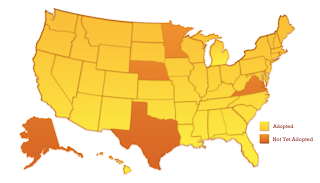My son never took the first half of U.S. History in high school. When he began ninth grade in Texas, he took the second half, along with those who had studied the first half in eighth grade. As it turned out, he had absorbed so much of his parents' knowledge that he knew more than his classmates. That works if you grow up in an education-rich household, but what about those many students who don't?
The not-unreasonable idea originally driving the push for a Common Core was to prevent such scenarios from occurring as students move from one school district to another, one city to another, and one state to another.
Common Core opponents decry this move by the federal government to impose a standard curriculum across America; proponents claim that the standards are not those of the federal government. Both sides are correct!
Where did the Common Core come from? Educrats, of course. To be more specific, according to the sponsors, a consortium of the National Governors Association and the Council of State School Officers (state education superintendents). I believe you will agree with me that few of any members of either organization actually wrote or worked on the standards. No, that work was delegated to committees--one to write the standards; one to validate the standards. Bottom line: five or six people actually wrote them, and practically no classroom teachers were involved in any of the process. Adoption of the Common Core also became a major goal of the Bill & Melinda Gates Foundation.
Though the feds did not write the standards, the Obama administration has embraced them wholeheartedly, so much so that it has tied federal funds (such as Race to the Top recently gained by CCSD) to a state's adoption of the Common Core. Jim Rex, our previous state superintendent, signed on wholeheartedly' Mick Zais has been left holding the bag. South Carolina is in the middle of transitioning with a completion deadline in 2015. Texas remains a hold out.
Having skimmed an analysis of the differences between content (at the fourth-grade level) of the Common Core and South Carolina curricula, I reached the conclusion that content overlapped by about 90 percent. Others have reached similar conclusions.
The most controversial aspect of the new curriculum is its new emphasis on "real-world" reading selections from K-12. What does "real world" mean to you? Apparently to some teachers it means find "gritty" readings about "gangstas" and rap--in elementary school. Common Core does not proscribe specific readings, just "real world." The idea differs wildly from the Common Knowledge Curriculum advocated by E.D. Hirsch, Jr., even as it sounds similar.
When Ronald Reagan first ran for President, he advocated abolishing the U.S. Department of Education. Too bad he didn't follow through. Now states and school districts cannot get enough of Other Peoples' Money (i.e., federal tax dollars) to the point that they will do jump through any hoop, advisable or not. The big winners are in the edublob: new teacher-training seminars, new teaching materials, new textbooks, and--oh, yes--new national tests on the Common Core that will be used to evaluate value added to each student by teachers.
In Shakespeare's
The Tempest, the naive Miranda, upon seeing for the first time the villains who plotted her and her father's deaths, remarks, "Oh, brave new world, that has such people in it."
It's not the first time that an idea that looks good on the surface has unintended consequences, evil ones at that, lurking beneath.




 n
n -vûr
-vûr s
s -t
-t )
) niversit
niversit s, from Latin, the whole, a corporate body, from
s, from Latin, the whole, a corporate body, from 










